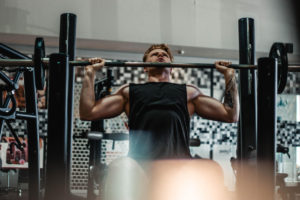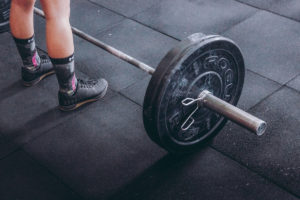Yes. Blog over! Just kidding — if you’re curious about what separates powerlifting from weightlifting, this blog will explain everything you need to know about these exercise types and how to stay safe while training.
What Is Powerlifting?
Powerlifting is a form of strength training that emphasises the “Big Three” lifts: the squat, the deadlift, and the bench press.
During powerlifting competitions, athletes strive to lift the heaviest weight possible while performing each exercise. They’re divided by gender, weight, and age and then get three attempts to reach their maximum weight (also known as their one-rep max).
An athlete’s powerlifting total is determined by adding their heaviest squat, bench press, and deadlift weights. The person with the highest total wins.
What Is Weightlifting?
Weightlifting is a form of strength training and the Olympic program’s only barbell sport. It’s also known as Olympic-style weightlifting or Olympic lifting.
This form of strength training emphasises two lifts: the snatch and clean and jerk.
In weightlifting competitions, classes are based on gender and weight. Each athlete gets three attempts to perform their two lifts. Their total score is then calculated by adding the weights from their best lifts.
What’s the Difference?
Powerlifting and weightlifting certainly aren’t synonyms. The following are some of the most noteworthy differences between the two:
Key Lifts
The first difference between powerlifting vs. weightlifting is the lifts performed.
Powerlifters perform squats, deadlifts, and bench presses. Weightlifters perform snatches and clean and jerks.
Both types of exercise require upper body strength, but powerlifting does not involve any overhead movements. Both primary weightlifting exercises require athletes to lift the barbell over their heads.
Essential Skills and Techniques
Another difference between powerlifting and weightlifting is the skill and technique required for each exercise.
Powerlifters and weightlifters both have a great deal of skill. However, each type of athlete utilises different techniques to improve their performance.
For example, powerlifters rely primarily on strength. Their number one goal is to lift the heaviest weight possible.
Weightlifters must also develop strength. However, they also need to focus on other techniques like coordination, flexibility, and explosiveness.
Performance Speed
When you watch someone perform a powerlifting exercise like a squat or bench press, you’ll notice that they move much slower than a weightlifter. They’re working hard to squat, push, or pull the most weight, and they’re willing to take as long as they need to hit their one-rep max.
Weightlifters move more quickly than powerlifters. Their movements are explosive because they have to simultaneously engage more muscle groups in the upper and lower body.
Range of Motion
Weightlifting requires a greater range of motion than powerlifting.
Weightlifters need more flexibility to lift a barbell from the ground and then bring it up over their heads. Without an adequate range of motion, they won’t be able to perform the lift correctly and are at risk of getting injured.
Powerlifters strive to lift the most weight and make the movement as efficient as possible.
They do this by actually minimising their range of motion and reducing the distance the barbell has to travel. For example, powerlifters often arch their backs significantly when performing bench presses or widen the distance between their feet when deadlifting.
Failure
In powerlifting, an athlete fails if they cannot lift a particular weight. In weightlifting, an athlete fails if they do not open their joints in the correct sequence.
Because powerlifters move more slowly, it’s easier for them to self-correct during the lift. Weightlifters move so quickly that it’s hard to correct mid-motion, meaning they have a greater chance of failing.
How to Work Out Safely and Avoid Injury
Both powerlifting and weightlifting require skill and proper technique. You could get hurt if you’re inexperienced or lifting weights that are too heavy. To stay safe while working out (either as a powerlifter or a weightlifter), keep these tips in mind:
Warm Up Properly
Weightlifters, powerlifters, and other athletes often get hurt because they failed to warm up properly (or didn’t warm up at all).
Warming up with some mobility exercises and light lifts helps you increase your body temperature, improve blood flow, and prepare your muscles for the movements you’re about to perform.
If you’re unsure how to properly warm up, don’t hesitate to ask one of our friendly staff. Here at In2Performance your well-being is our priority.
Increase Weight Slowly
Ego and impatience can also increase your risk of injury.
Your ego becomes a problem when you put too much weight on the barbell too quickly because you’re trying to beat your record or outshine one of your fellow athletes.
Similarly, if you’re impatient and add extra weight too quickly because you want to get to your max faster, you could also get hurt.
Take advantage of the wide range of weights available at In2Performance and map out a sustainable plan for achieving your strength goals. Remember, Rome wasn’t built in a day.
Modify or Scale Back When Necessary
If you’re not feeling your best but push through a workout anyway, you’re more likely to injure yourself. If something feels off or you’re struggling, it’s okay to modify a movement or scale back the weight. It’s better to back off and listen to your body than to overexert yourself and get hurt.
Take Days Off
Powerlifting and weightlifting workouts are both taxing.
You need to take time off between training sessions to give your muscles a chance to recover — otherwise, your injury risk and burnout risk increase.
Work with a Professional
You’re never too old or too skilled to learn something new. If you don’t have experience in powerlifting or weightlifting, or if you’ve hit a training plateau, working with one of In2Performance’s experienced coaches is a great way to improve your lifts and stay safe while doing it.
Need some help mastering the basics or refining your technique? In2Performance has a team of professional coaches ready to guide you and help you achieve your goals!
Want to Get Started on Your Fitness Journey?
Are you interested in giving powerlifting a try? If you’re in Melbourne, join us at In2Performance. Our gym is open and staffed 24-7, and we offer state-of-the-art equipment to help you maximise every training session.
In2Performance offers a range of memberships for powerlifting, strongman, CrossFit and more. Have a click around our website and if you’re interested in joining, sign up today — we’d love to see you on the floor!




